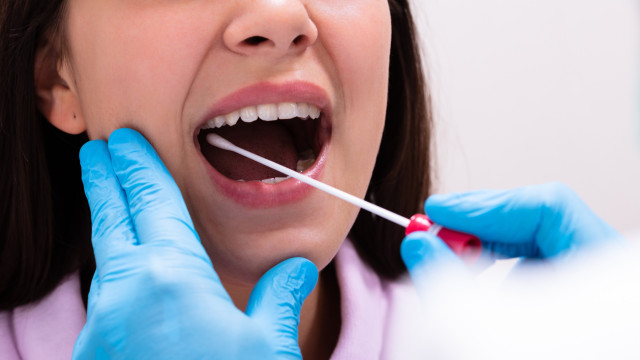






























See Also
See Again
© Shutterstock
0 / 31 Fotos
What exactly is a stroke?
- According to the WHO, a stroke occurs when the blood supply to the brain is interrupted, depriving brain cells of oxygen and nutrients. This can lead to cell death and disability.
© Shutterstock
1 / 31 Fotos
Global issue
- In 2021, stroke was among the leading global causes of death, along with ischaemic heart disease and COVID-19.
© Shutterstock
2 / 31 Fotos
Main causes of death
- About one in 10 people worldwide die from stroke. It's the third leading cause of death globally, and the fifth leading cause of death in the US.
© Shutterstock
3 / 31 Fotos
Growing numbers
- Research suggests that strokes could lead to 10 million deaths a year by 2050. This is due to population growth and aging.
© Shutterstock
4 / 31 Fotos
Affecting younger people
- While strokes typically affect older people, a recent report released by the US Centers for Disease Control and Prevention (CDC) found a concerning trend: deaths from stroke among Americans aged 45-64 increased by 19% from 2013 to 2019.
© Shutterstock
5 / 31 Fotos
Affecting younger people
- This was confirmed by a new study in the Lancet Neurology journal, which found that while stroke rates declined among adults over 70, they increased among younger adults, particularly those under 55.
© Shutterstock
6 / 31 Fotos
Concerning stats
- "It's important to know that stroke can happen at any age," says Omoye Imoisili, an internal medicine doctor and lead author of the CDC study. This is particularly alarming, as stroke prevalence among 18-44-year-olds rose by a tenth of a percentage point, representing a relative increase of 15 percent.
© Shutterstock
7 / 31 Fotos
Why the increase?
- While younger adults still make up a small proportion of overall strokes, rates are climbing quickly in these younger groups with no increases seen in older adults. But why?
© Shutterstock
8 / 31 Fotos
Obesity
- Since 1990, obesity's contribution to stroke risk has risen by 88% globally. Excess weight can strain the heart and blood vessels, leading to high blood pressure, type 2 diabetes, and high cholesterol. These conditions contribute to plaque buildup in the arteries, increasing the risk of blood clots and stroke.
© Shutterstock
9 / 31 Fotos
Sugar intake
- The study also linked an increase in stroke cases to the rising consumption of sugar-sweetened beverages. High blood sugar levels can damage blood vessels, leading to inflammation, nerve damage, and blood clot formation.
© Shutterstock
10 / 31 Fotos
Air pollution
- Air pollution accounts for about 30% of worldwide strokes. This includes pollution from outdoor and indoor sources, such as household burning of fuels.
© Getty Images
11 / 31 Fotos
Climate change
- According to the Lancet study, the impact of higher air temperatures on stroke incidence has increased by 72%. While higher temperatures are a concern, temperature extremes in both directions can influence stroke risk.
© Getty Images
12 / 31 Fotos
Climate change
- Recent studies suggest that cold temperatures may have a more significant impact on stroke rates and deaths than hot temperatures.
© Getty Images
13 / 31 Fotos
Opioid abuse
- The CDC report suggests that the opioid epidemic may have contributed to the rise in stroke rates. States like Ohio and Tennessee, hard-hit by the opioid crisis, experienced significant increases in stroke cases.
© Shutterstock
14 / 31 Fotos
Chronic conditions
- Poorly managed diabetes can lead to high cholesterol, high blood sugar, and high blood pressure, all of which are major risk factors for stroke. The report indicates that the rising prevalence of type 2 diabetes among young adults has contributed to an increase in stroke cases over the past 15 years.
© Shutterstock
15 / 31 Fotos
Socioeconomic factors
- Certain communities, including Native Americans, Native Hawaiians/Pacific Islanders, and Black Americans, experienced higher rates of stroke. The CDC study suggests that this may be due to factors such as chronic health conditions, socioeconomic disparities, and systemic barriers to healthcare.
© Getty Images
16 / 31 Fotos
Main risk
- However, the single biggest risk factor for stroke worldwide—including among young adults—is still high blood pressure, accounting for over half of all cases, as the Lancet study points out.
© Shutterstock
17 / 31 Fotos
“Silent killer”
- A recent study published in JAMA Network Open revealed that over half of all Americans with high blood pressure are unaware of their condition, including a staggering 93% of those aged 18 to 44.
© Shutterstock
18 / 31 Fotos
Monitoring is key
- It's not just those with extremely high blood pressure who are at risk. Valery Feigin, a stroke researcher and lead author of the Lancet study, highlights that most strokes and heart attacks occur in individuals with only slightly elevated blood pressure.
© Shutterstock
19 / 31 Fotos
Bright side
- The good news is that high blood pressure can be managed easily. A healthy blood pressure reading is below 120/80, which can be achieved through lifestyle changes and, if necessary, medication.
© Shutterstock
20 / 31 Fotos
Prevention
- Feigin emphasizes that the vast majority of strokes are preventable. Consulting with a doctor to check blood pressure and assess personal risk factors, such as family history and lifestyle, is a crucial first step.
© Shutterstock
21 / 31 Fotos
Lifestyle changes
- The next step is to make gradual lifestyle changes to reduce weight, high blood pressure, and high blood sugar.
© Shutterstock
22 / 31 Fotos
Sodium intake
- One major lifestyle change to lower blood pressure is reducing sodium intake, Feigin says. When we consume too much sodium, our bodies retain more water, which increases blood volume and puts extra strain on the heart and blood vessels.
© Shutterstock
23 / 31 Fotos
Ultra processed foods
- Ultra-processed foods, like processed meats, salty snacks, and condiments like ketchup, are major sources of excess sodium in our diets. To reduce sodium intake, it's important to be mindful of food labels and choose low-sodium options.
© Shutterstock
24 / 31 Fotos
Sugary drinks
- Sugar-sweetened beverages, such as soda, juice, and energy drinks, contribute significantly to high blood sugar levels. Consuming these drinks regularly can increase the risk of obesity, type 2 diabetes, and other health problems, all of which are linked to stroke.
© Shutterstock
25 / 31 Fotos
Weight
- Excess weight can lead to health conditions like high blood pressure, high cholesterol, and type 2 diabetes, increasing the risk of stroke. A balanced diet rich in healthy fats, protein, and fiber is essential for weight management and overall health.
© Shutterstock
26 / 31 Fotos
Physical activity
- Regular exercise is not only effective for weight management. It helps lower LDL ("bad") cholesterol, raise HDL cholesterol, reduce blood pressure, and manage stress levels, all of which contribute to a reduced risk of heart disease and stroke.
© Shutterstock
27 / 31 Fotos
Tobacco
- Another major risk factor for stroke, smoking damages blood vessels, increases blood pressure, and accelerates plaque buildup in the arteries. Quitting can significantly reduce the risk of stroke and improve overall health.
© Shutterstock
28 / 31 Fotos
Alcohol
- Beyond elevating blood pressure, alcohol abuse can damage the heart muscle, increase the risk of atrial fibrillation, and impair liver function. These factors can lead to blood clots and increase the risk of stroke. Reducing or eliminating alcohol consumption is an important preventive measure.
© Shutterstock
29 / 31 Fotos
Cholesterol control
- To reduce high LDL cholesterol levels, specialists recommend limiting intake of red meat, full-fat dairy products, and processed foods. In turn, consuming more fiber-rich foods and healthy fats, and engaging in regular physical activity can help balance cholesterol levels. Sources: (National Geographic) (World Health Organization) (World Stroke Organization-Lancet Neurology Commission Stroke Collaboration Group)
© Shutterstock
30 / 31 Fotos
© Shutterstock
0 / 31 Fotos
What exactly is a stroke?
- According to the WHO, a stroke occurs when the blood supply to the brain is interrupted, depriving brain cells of oxygen and nutrients. This can lead to cell death and disability.
© Shutterstock
1 / 31 Fotos
Global issue
- In 2021, stroke was among the leading global causes of death, along with ischaemic heart disease and COVID-19.
© Shutterstock
2 / 31 Fotos
Main causes of death
- About one in 10 people worldwide die from stroke. It's the third leading cause of death globally, and the fifth leading cause of death in the US.
© Shutterstock
3 / 31 Fotos
Growing numbers
- Research suggests that strokes could lead to 10 million deaths a year by 2050. This is due to population growth and aging.
© Shutterstock
4 / 31 Fotos
Affecting younger people
- While strokes typically affect older people, a recent report released by the US Centers for Disease Control and Prevention (CDC) found a concerning trend: deaths from stroke among Americans aged 45-64 increased by 19% from 2013 to 2019.
© Shutterstock
5 / 31 Fotos
Affecting younger people
- This was confirmed by a new study in the Lancet Neurology journal, which found that while stroke rates declined among adults over 70, they increased among younger adults, particularly those under 55.
© Shutterstock
6 / 31 Fotos
Concerning stats
- "It's important to know that stroke can happen at any age," says Omoye Imoisili, an internal medicine doctor and lead author of the CDC study. This is particularly alarming, as stroke prevalence among 18-44-year-olds rose by a tenth of a percentage point, representing a relative increase of 15 percent.
© Shutterstock
7 / 31 Fotos
Why the increase?
- While younger adults still make up a small proportion of overall strokes, rates are climbing quickly in these younger groups with no increases seen in older adults. But why?
© Shutterstock
8 / 31 Fotos
Obesity
- Since 1990, obesity's contribution to stroke risk has risen by 88% globally. Excess weight can strain the heart and blood vessels, leading to high blood pressure, type 2 diabetes, and high cholesterol. These conditions contribute to plaque buildup in the arteries, increasing the risk of blood clots and stroke.
© Shutterstock
9 / 31 Fotos
Sugar intake
- The study also linked an increase in stroke cases to the rising consumption of sugar-sweetened beverages. High blood sugar levels can damage blood vessels, leading to inflammation, nerve damage, and blood clot formation.
© Shutterstock
10 / 31 Fotos
Air pollution
- Air pollution accounts for about 30% of worldwide strokes. This includes pollution from outdoor and indoor sources, such as household burning of fuels.
© Getty Images
11 / 31 Fotos
Climate change
- According to the Lancet study, the impact of higher air temperatures on stroke incidence has increased by 72%. While higher temperatures are a concern, temperature extremes in both directions can influence stroke risk.
© Getty Images
12 / 31 Fotos
Climate change
- Recent studies suggest that cold temperatures may have a more significant impact on stroke rates and deaths than hot temperatures.
© Getty Images
13 / 31 Fotos
Opioid abuse
- The CDC report suggests that the opioid epidemic may have contributed to the rise in stroke rates. States like Ohio and Tennessee, hard-hit by the opioid crisis, experienced significant increases in stroke cases.
© Shutterstock
14 / 31 Fotos
Chronic conditions
- Poorly managed diabetes can lead to high cholesterol, high blood sugar, and high blood pressure, all of which are major risk factors for stroke. The report indicates that the rising prevalence of type 2 diabetes among young adults has contributed to an increase in stroke cases over the past 15 years.
© Shutterstock
15 / 31 Fotos
Socioeconomic factors
- Certain communities, including Native Americans, Native Hawaiians/Pacific Islanders, and Black Americans, experienced higher rates of stroke. The CDC study suggests that this may be due to factors such as chronic health conditions, socioeconomic disparities, and systemic barriers to healthcare.
© Getty Images
16 / 31 Fotos
Main risk
- However, the single biggest risk factor for stroke worldwide—including among young adults—is still high blood pressure, accounting for over half of all cases, as the Lancet study points out.
© Shutterstock
17 / 31 Fotos
“Silent killer”
- A recent study published in JAMA Network Open revealed that over half of all Americans with high blood pressure are unaware of their condition, including a staggering 93% of those aged 18 to 44.
© Shutterstock
18 / 31 Fotos
Monitoring is key
- It's not just those with extremely high blood pressure who are at risk. Valery Feigin, a stroke researcher and lead author of the Lancet study, highlights that most strokes and heart attacks occur in individuals with only slightly elevated blood pressure.
© Shutterstock
19 / 31 Fotos
Bright side
- The good news is that high blood pressure can be managed easily. A healthy blood pressure reading is below 120/80, which can be achieved through lifestyle changes and, if necessary, medication.
© Shutterstock
20 / 31 Fotos
Prevention
- Feigin emphasizes that the vast majority of strokes are preventable. Consulting with a doctor to check blood pressure and assess personal risk factors, such as family history and lifestyle, is a crucial first step.
© Shutterstock
21 / 31 Fotos
Lifestyle changes
- The next step is to make gradual lifestyle changes to reduce weight, high blood pressure, and high blood sugar.
© Shutterstock
22 / 31 Fotos
Sodium intake
- One major lifestyle change to lower blood pressure is reducing sodium intake, Feigin says. When we consume too much sodium, our bodies retain more water, which increases blood volume and puts extra strain on the heart and blood vessels.
© Shutterstock
23 / 31 Fotos
Ultra processed foods
- Ultra-processed foods, like processed meats, salty snacks, and condiments like ketchup, are major sources of excess sodium in our diets. To reduce sodium intake, it's important to be mindful of food labels and choose low-sodium options.
© Shutterstock
24 / 31 Fotos
Sugary drinks
- Sugar-sweetened beverages, such as soda, juice, and energy drinks, contribute significantly to high blood sugar levels. Consuming these drinks regularly can increase the risk of obesity, type 2 diabetes, and other health problems, all of which are linked to stroke.
© Shutterstock
25 / 31 Fotos
Weight
- Excess weight can lead to health conditions like high blood pressure, high cholesterol, and type 2 diabetes, increasing the risk of stroke. A balanced diet rich in healthy fats, protein, and fiber is essential for weight management and overall health.
© Shutterstock
26 / 31 Fotos
Physical activity
- Regular exercise is not only effective for weight management. It helps lower LDL ("bad") cholesterol, raise HDL cholesterol, reduce blood pressure, and manage stress levels, all of which contribute to a reduced risk of heart disease and stroke.
© Shutterstock
27 / 31 Fotos
Tobacco
- Another major risk factor for stroke, smoking damages blood vessels, increases blood pressure, and accelerates plaque buildup in the arteries. Quitting can significantly reduce the risk of stroke and improve overall health.
© Shutterstock
28 / 31 Fotos
Alcohol
- Beyond elevating blood pressure, alcohol abuse can damage the heart muscle, increase the risk of atrial fibrillation, and impair liver function. These factors can lead to blood clots and increase the risk of stroke. Reducing or eliminating alcohol consumption is an important preventive measure.
© Shutterstock
29 / 31 Fotos
Cholesterol control
- To reduce high LDL cholesterol levels, specialists recommend limiting intake of red meat, full-fat dairy products, and processed foods. In turn, consuming more fiber-rich foods and healthy fats, and engaging in regular physical activity can help balance cholesterol levels. Sources: (National Geographic) (World Health Organization) (World Stroke Organization-Lancet Neurology Commission Stroke Collaboration Group)
© Shutterstock
30 / 31 Fotos
Strokes are on the rise among younger adults
Stroke is the third leading cause of death in the world
© Shutterstock
Stroke, a serious cardiovascular condition, is the third leading cause of death worldwide, according to the World Health Organization (WHO). It can have devastating consequences, including paralysis and cognitive impairment.
While it has historically affected older adults, recent studies indicate a concerning rise in stroke cases among younger people. This gallery explores the reasons behind this alarming trend and provides insights into prevention strategies. Click through to get started.
RECOMMENDED FOR YOU




































MOST READ
- Last Hour
- Last Day
- Last Week








